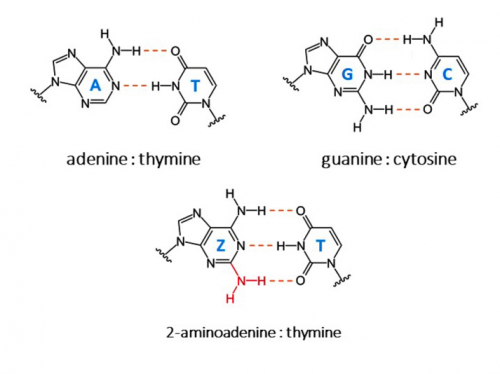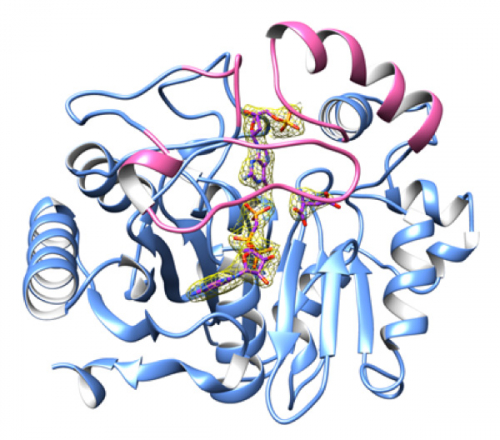In all living organisms, genomic DNA is made up of four nucleotide bases: A, T, C and G, for adenine, thymine, cytosine and guanine. All, except genomic DNA of certain bacteriophages (viruses infecting bacteria) which is composed of ZCGT bases: base A is replaced by diaminopurine, called Z, which binds to thymine in the same way than with adenine, but by forming three hydrogen bonds with it instead of two.
The 3D structure of PurZ enzyme, responsible for Z synthesis, was determined using X-ray diffraction data collected on the two SOLEIL bio-crystallography beamlines, PROXIMA-1 and PROXIMA-2A.
The results are published in Science.

Figure 1: hydrogen bonds between bases A-T, G-C and Z-T
The first ZCGT genome was detected in 1977 by Russian scientists, in the S-2L bacteriophage infecting a cyanobacterium. This case remained unique for many years - since then, several other bacteriophages containing a ZCGT genome have been identified.
Sequencing of the S-2L genome at Institut Pasteur in 1998 identified a gene encoding a protein, called PurZ, showing homologies with the well-known PurA protein, also called adenylosuccinate synthase. PurA is the enzyme that catalyzes the first step of adenine biosynthesis, so scientists made the hypothesis that the PurZ protein could be responsible for the first step in biosynthesis of base Z.
The resolution of PurZ 3D structure, alone and in a complex with the molecules needed for the first step of Z biosynthesis (dGMP, AMPPcP and aspartate in figure 2) and reaction products, was determined using X-ray diffraction data collected on the two SOLEIL bio-crystallography beamlines, PROXIMA-1 and PROXIMA-2A.

Figure 2: PurZ enzyme linked to the 3 molecules involved in the first step of Z biosynthesis: dGMP, AMPPcP and aspartate, visible between the helices and the ribbons of the enzyme.
A phylogenetic analysis of this family of enzymes revealed a link between PurZ and the enzyme called PurA in archaea. This indicated that PurZ is an ancient enzyme that likely conferred an evolutionary advantage for the bacteriophages containing a ZCGT genome.
The new ZT base pair and the discovery of the biosynthetic pathway revealed that new bases can be incorporated enzymatically into genetic material. This increases the number of coding bases in DNA, paving the way for the development of synthetic genetic biopolymers.
